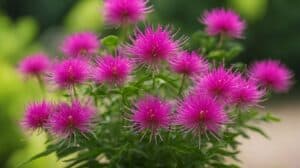Propagating Zebra Plants: A Novice’s Guide to Aphelandra Squarrosa

Zebra plants, also known as Aphelandra squarrosa, are tropical plants that are known for their striking foliage.
They have large, green leaves with white veins that resemble a zebra’s stripes, hence their name.
While they can be a bit challenging to care for, propagating zebra plants is a great way to expand your collection and share the beauty of these unique plants with others.
In this article, we will provide a novice’s guide to propagating zebra plants.
Whether you’re a seasoned plant parent or just starting out, this guide will give you all the information you need to successfully propagate your zebra plant.
We’ll cover everything from the best time to propagate to the different methods you can use, so you can find the one that works best for you.
So, let’s get started and learn how to propagate zebra plants!
Understanding Zebra Plants
Species Overview
Aphelandra Squarrosa, commonly known as Zebra Plant, is a tropical plant native to South America.
It is a popular houseplant due to its striking foliage, which features white stripes on dark green leaves.
The plant can grow up to 2 feet tall and 1.5 feet wide, and it produces bright yellow flowers in the summer.
Zebra Plants belong to the family Acanthaceae and are related to other popular houseplants such as the Prayer Plant and the Calathea.
There are several cultivars of Zebra Plant available, each with slightly different leaf patterns and colors.
Ideal Growing Conditions
To thrive, Zebra Plants require warm temperatures, high humidity, and bright, indirect light.
They prefer well-draining soil that is kept evenly moist, but not waterlogged.
It is important to avoid overwatering, as this can lead to root rot and other issues.
Zebra Plants can be propagated through stem cuttings, which should be taken in the spring or summer.
The cuttings should be placed in a well-draining potting mix and kept in a warm, humid location with bright, indirect light.
With proper care, the cuttings should root within a few weeks.
Overall, Zebra Plants are a great choice for novice plant enthusiasts looking to add some tropical flair to their indoor spaces.
With the right conditions and care, these plants can thrive and provide years of enjoyment.
Propagation Techniques

Propagating zebra plants is an easy way to multiply your collection.
There are three main propagation techniques for Aphelandra squarrosa: leaf cuttings, stem cuttings, and division.
Leaf Cuttings
Leaf cuttings are a simple and effective way to propagate zebra plants.
To do this, select a healthy leaf and remove it from the plant. Cut the leaf into sections, making sure that each section has a vein running down the middle.
Dip the cut end of each section in rooting hormone and place it in a pot filled with moist potting soil.
Keep the soil moist and the cutting in a warm, bright location. After a few weeks, the cutting should start to root and a new plant will begin to grow.
Stem Cuttings
Stem cuttings are another easy way to propagate zebra plants.
To do this, select a healthy stem and cut it into sections, making sure that each section has at least one node.
Dip the cut end of each section in rooting hormone and place it in a pot filled with moist potting soil.
Keep the soil moist and the cutting in a warm, bright location. After a few weeks, the cutting should start to root and a new plant will begin to grow.
Division
Division is a simple way to propagate zebra plants that have become too large for their pot.
To do this, carefully remove the plant from its pot and gently separate the clumps of roots. Each clump can be replanted in its own pot with fresh potting soil.
Water the newly potted plants and keep them in a warm, bright location. After a few weeks, the new plants should start to grow.
Overall, propagating zebra plants is an easy way to increase your collection.
By using these simple techniques, even novice gardeners can enjoy the beauty of Aphelandra squarrosa in their homes.
Post-Propagation Care

After successfully propagating the zebra plant, it’s important to provide proper care to ensure its healthy growth.
This section will cover the potting and soil requirements, watering and feeding, and light and temperature needs of the plant.
Potting and Soil Requirements
When potting the newly propagated zebra plant, it’s essential to use a well-draining soil mix.
A suitable mix can be made by combining equal parts of peat moss, perlite, and sand.
It’s also recommended to add a small amount of slow-release fertilizer to the mix to provide nutrients over time.
The pot size should be chosen based on the size of the propagated plant.
A pot that is slightly larger than the root ball is recommended to allow room for growth.
It’s also essential to choose a pot with drainage holes to prevent waterlogging.
Watering and Feeding
The zebra plant prefers consistently moist soil but can’t tolerate waterlogged soil.
It’s recommended to water the plant when the top inch of soil feels dry to the touch.
During the growing season, the plant should be fertilized every two weeks with a balanced liquid fertilizer.
It’s essential to avoid overwatering the plant, as this can lead to root rot.
To prevent this, it’s recommended to allow the soil to dry out slightly between waterings.
Light and Temperature
The zebra plant prefers bright, indirect light and can’t tolerate direct sunlight.
It’s recommended to place the plant near a north or east-facing window.
The plant can also be grown under fluorescent lights if natural light isn’t available.
The ideal temperature range for the zebra plant is between 60-75°F (15-24°C).
It’s essential to avoid placing the plant near cold drafts or heat sources, such as radiators or air conditioning vents.
By following these care guidelines, novice gardeners can successfully grow and maintain healthy zebra plants.
Troubleshooting Common Issues

Pest Management
Zebra plants are susceptible to pest infestations, such as spider mites and mealybugs.
To prevent these pests from attacking your plant, regularly inspect it for signs of infestation, such as webbing or white, cottony patches.
If you notice any signs of pests, immediately isolate the affected plant to prevent the infestation from spreading to other plants.
To treat pest infestations, use a solution of water and mild soap or neem oil to spray the affected areas.
Be sure to thoroughly coat both the tops and bottoms of the leaves, as well as the stems.
Repeat this treatment every few days until the infestation is under control.
Disease Prevention
Zebra plants are also prone to fungal infections, such as leaf spot and powdery mildew.
To prevent these diseases, avoid overwatering your plant and ensure that it is planted in well-draining soil.
Additionally, avoid getting water on the leaves when watering your plant, as this can create a moist environment that is conducive to fungal growth.
If you notice any signs of fungal infection, such as brown or yellow spots on the leaves, immediately remove the affected leaves and dispose of them.
Treat the remaining plant with a fungicide, following the instructions on the label.
Growth Problems
If your zebra plant is not growing as well as you would like, there are a few things you can do to encourage growth.
First, ensure that the plant is receiving enough light.
Zebra plants prefer bright, indirect light, so consider moving it to a brighter location if necessary.
Additionally, make sure that the plant is receiving enough nutrients.
Fertilize your zebra plant every few weeks with a balanced fertilizer, following the instructions on the label.
Finally, ensure that the plant is not root-bound, as this can restrict growth. If necessary, repot the plant into a larger pot with fresh soil.
Frequently Asked Questions

What’s the best method for propagating a Zebra Plant?
The most successful method of propagating a Zebra Plant is through stem cuttings.
Take a cutting of about 4-6 inches long, remove the lower leaves, and dip the cut end in rooting hormone.
Then, plant the cutting in well-draining soil and keep it moist until roots develop.
Is it possible to root a Zebra Plant in water, and if so, how?
Yes, it is possible to root a Zebra Plant in water. Simply take a cutting and place it in a jar of water, making sure the cut end is submerged.
Change the water every few days to prevent bacteria growth and wait for roots to develop before transferring the cutting to soil.
What is the maximum size a Zebra Plant can reach?
A mature Zebra Plant can reach up to 2-3 feet in height and width.
Can I prune the top of my Zebra Plant to encourage growth?
Yes, pruning the top of your Zebra Plant can encourage bushier growth. Simply cut back the top portion of the stem, just above a leaf node.
How often should I water my Zebra Plant cuttings during propagation?
During propagation, it’s important to keep the soil moist but not waterlogged. Water the cuttings when the top inch of soil feels dry to the touch.
What type of soil is ideal for rooting Zebra Plant cuttings?
A well-draining soil mix that is high in organic matter is ideal for rooting Zebra Plant cuttings.
A mix of peat moss, perlite, and vermiculite or sand is a good option.












